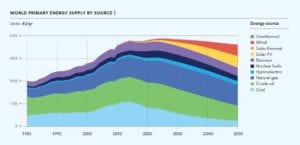
Natural gas will become the largest single source of energy from 2035 according to a recent report by DNV GL
The forecast of the energy transition notes that while renewable energy will grow its share of the energy mix, oil and gas will account for 44% of world energy supply in 2050, compared to 53% today
DNV GL’s Energy Transition Outlook (ETO), a forecast that spans the global energy mix to 2050, predicts that global demand for energy will flatten in 2030, and then steadily decline over the next two decades, thanks to step-changes in energy efficiency.
As the fossil fuel share of the world’s primary energy mix reduces from 81% currently to 52% in 2050, gas will continue to play a key role alongside renewables in helping to meet future, lower-carbon, energy requirements.
DNV GL says major oil companies intend to increase the share of gas in their reserves, and it expects an accelerated shift by 2022 as they decarbonise business portfolios.
Implementing strict cost control

while renewable energy will grow its share of the energy mix, oil and gas will account for 44% of world energy supply in 2050, compared to 53% today
While demand for hydrocarbons will peak over the next two decades, significant investment will be needed to add new oil and gas production capacity and operate existing assets safely and sustainably.
“We have seen impressive and important innovative efforts across the energy industry, resulting in cost saving and efficiency gains. The oil and gas industry must continue on a path of strict cost control to stay relevant.
“Coming from a tradition of technological achievements, and having the advantage of existing infrastructure and value chains, this industry has the potential to continue to contribute to energy security and shape our energy future,” says Elisabeth Tørstad, CEO, DNV GL – Oil & Gas.
“Increased digitalisation, standardisation and remote or autonomous operations will play a central role in achieving long-term cost savings and improving the oil and gas industry’s carbon footprint. We also expect the industry to turn to innovations in facility design, operating models and contracting strategies,” Tørstad adds.
DNV GL has published a suite of reports on the Energy Transition Outlook, which are available to download free of charge. The main ETO report covers the transition of the entire energy mix to 2050.

